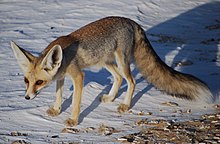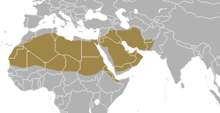Rüppell's fox
| Rüppell's fox | |
|---|---|
 |
|
| Scientific classification | |
| Kingdom: | Animalia |
| Phylum: | Chordata |
| Class: | Mammalia |
| Order: | Carnivora |
| Family: | Canidae |
| Genus: | Vulpes |
| Species: | V. rueppellii |
| Binomial name | |
|
Vulpes rueppellii (Schinz, 1825) |
|
 |
|
| Rüppell's fox range | |
Rüppell's fox (Vulpes rueppellii), also spelled Rueppell's fox, is a species of fox living in North Africa, the Middle East, and southwestern Asia. It is named after the German naturalist Eduard Rüppell. This fox is also called the sand fox, but this terminology is confusing because the corsac fox (V. corsac) and the Tibetan sand fox (V. ferrilata) are also known as "sand foxes".
Rüppell's fox is a small fox, measuring 66 to 74 cm (26 to 29 in) in total length, including a 27- to 30-cm tail. Males appear somewhat larger than females, but both sexes are reported to have an average weight of 1.7 kg (3.7 lb). The coat is sandy in color, ticked with numerous white hairs, and fading from reddish along the middle of the back to pure white on the animal's underparts and on the tip of its tail. The head has a more rusty tone on the muzzle and forehead, with dark brown patches on the sides of the muzzle, stretching up towards the eyes. The chin and the sides of the face are white. The whiskers are long, reaching 7 cm (2.8 in), and the tail is bushy.
Rüppell's fox has fur on the pads on its feet, that possibly helps distribute its weight and move easily on sand, and keeps the hot sand from burning its feet. Similar to other desert-dwelling foxes, Rüppell's fox has large ears to cool it off. Although adults are too large to confuse with fennec foxes, which live in the same area, young Rüppell's foxes can be confused with adults of that species. The larger ears, however, make them easy to distinguish from red and pale foxes, which also live in some the same areas. In addition, the coat of a Rüppell's fox is much paler than that of a red fox, while pale foxes lack the white tips on their tails.
Rüppell's fox is found across North Africa south of the Atlas Mountains, from Mauritania and Morocco in the west to Egypt and Djibouti in the east. It is also found in the Arabian Peninsula southwards from Syria and Iraq, and as far east as Iran, Pakistan, and Afghanistan. Within this region, it prefers sandy or rocky deserts, but may also be found in semiarid steppes and sparse scrub.
...
Wikipedia

